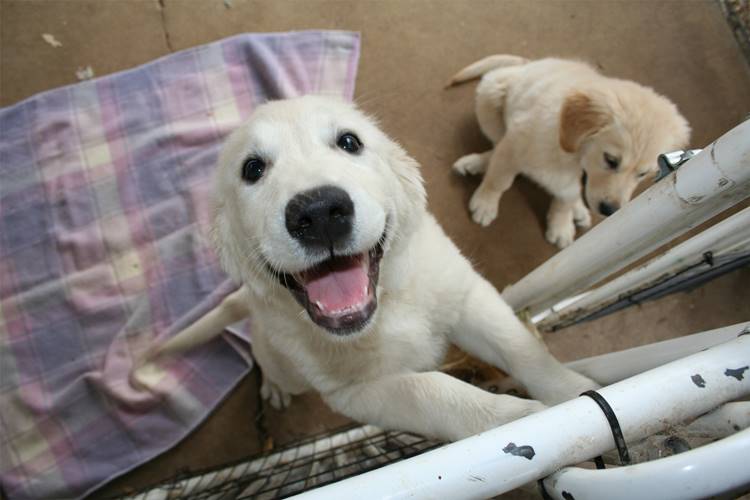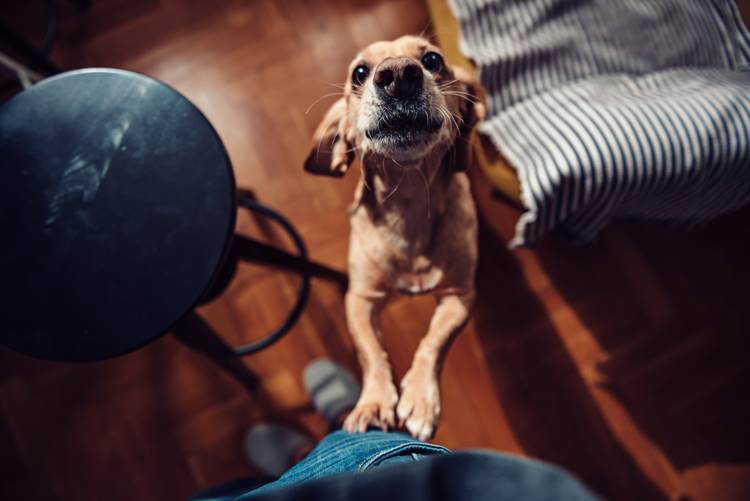How to Teach Your Dog Not to Jump in Minutes
by dogtoyadvisor | Last updated on November 18, 2020
We only review products we tested ourselves. We have affiliate partnerships, so we get a share of the revenue from your purchase.

It was cute at first, seeing how excited your dog got around you, him jumping on you each time you got home from work like he hadn’t seen you in weeks!
Overtime, it got harder to deal with. He’ll scratch, ruin your clothes and sometimes you’ll even stumble, trying to walk with an excited pooch jumping around and trying to hang on to you.
And we won’t even mention your friend/family’s reaction whenever they visit.
Learning how to stop a dog from jumping on people is important, not only for your daily interaction with your dog, but also for safety reasons, particularly if we’re talking about a large dog.
But don’t worry, we’re here to help!
Why Dogs Jump On People
There are several reasons why your dog jumps on you or other people when they arrive in your home.
The first and most obvious is excitement.
He’s happy to see you, to greet you, he’s probably been waiting for you anxiously (even if you’ve left him for only a few hour).
Another reason that explains it is, he wants your undivided attention.
He wants you to notice him, to pay attention, he wants to be the center of your world like you’re his.
Also, he wants to know where you’ve been and the best way for him to do that is to sniff every inch of you.
Dogs learn differently than humans and if you understand how their mind works, you can solve MOST dog behavior issues.
Get The Right Gear
We are big fans of the clicker.
Clicker training is very efficient and having your dog associate the action you’re training him to perform to the click sound only makes is simpler for him to understand.
When training your dog to stop jumping on people, you’ll want to use the clicker every time your dogs does what he’s suppose to.
Each time he stops jumping, sits or ignores the person he’s training with, you’ll want to use the clicker so he’ll associate that behavior with the sound.
If the clicker is not your thing, you can always use treats to reward your dog’s good behavior.
Each time he obeys or as soon as he stops jumping, reward him with a tasty treat and make sure he’ll want to do it again and again.
Read also: how to use a clicker to train your dog
How To Train A Dog To Stop Jumping Up
How do you react when you want your dog to stop jumping on you?
We used to yell a lot, get desperate and think we’d never be able to change our dog’s behavior.
People will usually push them away or raise your knees and legs to block their access. Others will use harsher tactics to try and scare him away.
But this can hurt your dog, particularly if he’s overly excited. You might even end up kneeing him of kicking him in the belly or step on his paw.
Plus, the last thing you want your dog to feel around you is fear.
Here are some positive reinforcement techniques you can use do so it too!
Step 1 – Ignore your dog when he’s jumping
Just ignore him.
Don’t talk to him, don’t even look at him.
That also means no greeting, yelling or using any sort of command. Ideally go a step further, just turn your back to him and if he tries to go around him, just turn again and walk away.
You’ll do this for as long and as often as it takes for him to give up and stay still. Once he does, that’s when you’ll greet him, rewarding the intended behavior.
After a few days of consistently doing this, he’ll learn what you expect him to do and start doing it by himself.
But remember! He at some point he decides to bend the rules and try his luck, you must be consistent!
Step 2 – Teach your dog to sit
After getting your dog to stay still, command hit to sit.
Once he does, even if it’s very temporary, reward him for it as much as possible with attention, cuddles, treats, you name it, he’ll love it.
Repeat it as often as you can to make sure he learns what you expect from him.

From this moment on, the most effective way is to act instead of reacting. If you’re expecting company, be prepared to ask him to sit before they enter the house.
Also, when you get home, try and get him to sit as soon as you enter and reward him if he does.
Step 3 – Stop your dog from jumping on people
This can be tricky, because we’re talking about people he doesn’t see every day, so it’s a bit more difficult to train.
First you’ll need a volunteer family member or friend. He’ll need to leave and return a few times, always passing close to your dog.
If your dog tries to jump on him, he should ignore him as mentioned in step one.
Also, as you’ve done in Step 1, he should reward him each time your dog doesn’t jump, even if he just hesitates, it still shows improvement and rewarding him will let him know that’s what’s expected of him.
Repeat as needed until your dog learns how to do it alone.
Then, you’ll take the exercise outside. Leading your dog by the lead, ask your volunteer to walk up to you from a corner or somewhere your dog won’t see him at a distance.
Watch how your dog behaves and reinforce the exercise if necessary, repeating it as much as necessary.
Once he gets what the volunteer expects of him, you’ll just need to try the same with as many different people on as many different locations as possible.
Not only will this be a lot of fun for your dog, it will also be a great socializing experience!
Affiliate links / Images from Amazon Product Advertising and iStock
Recommending Reading:










I need advice on how to train my 2 dogs that aren’t young anymore, but are rescues that weren’t raised together to get along. The oldest one we have had for 9 years, then another dog showed up at my house 3 years ago and we got her spayed and kept her, but after a year she started attacking my older one (male) which is a lot smaller. It is getting very frustrating to have to constantly watch her because she will jump him at any time. It is strange though that when no one is here (I have a camera on them) where I can speak to them if needed, they get along just fine. I think it’s a jealousy issue. I need some kind of help though, I’m afraid she will really hurt him or kill him. She is about 50 pounds at 5 years old and he is 12 pounds at 12 years old. I would appreciate ANY help you could give me.
Hi Linda.
Having two older dogs not get along is very complicated.
Fist of all, kudos for rescuing your lovely dogs.
The main worry for me would be the difference in sizes and his age, she can really make some damage if she wants too.
It happening when you’re around could mean jealously, possessiveness or even anxiety.
Have you talked to their vet about it? Maybe (s)he can recommend a local trainer to give you some pointers on how to correct that behavior without making it worse.
We believe in positive reinforcement. And in this case it means two things.
When she pounces on your other dog, you need to correct to make sure she understands you don’t want her to do it (without punishment), then ignore her for a while until she calms down.
On the other hand, you want to reinforce positive behavior and you do that by making sure to create opportunities for them to interact positively in your presence and reward that behavior with everything and anything she values. Like feeding their favorite treats together.
That way she’ll learn how you want her to behave and, at the same time, that doing something that you don’t want won’t get her the attention she desires.
Be consistent about it and don’t give up, she’s not doing it because she wants to hurt him or she’d do it when they’re alone, she just doesn’t know any better.
Good luck and let us know how it goes!
Sandy
My great grandmother trained her dogs not to jump on anybody by doing it this quick but old fashioned way: when the dog jumped up on her she’d reach her foot out and step on the dog’s hind toes. Not enough to harm the dog but enough to make the dog feel uncomfortable. I tried it when we got our black lab. Took twice doing it and she never jumped on anyone again. Might take a bit longer on a more hardheaded or stupid breed but it was fast and effective and the dog never really knows you are the one causing it discomfort. It just knows that something a little painful happens when it jumps on people so it stops. Save the clicker and treats for other types of training. I think sometimes the old fashioned ways are the best ways.
Hi Madre
Thank you for your feedback.
We believe in positive reinforcement training.
So any sort of punishment or discomfort, while effective, “works” because it creates fear in the dog, meaning he’s not learning the right behavior you expect from him, he’s doing it out of fear.
Also, since we have a very insecure and nervous dogs, we try to shy away from anything that would actually make dogs feel more insecure or nervous.
A well-balanced dog responds to training out of rewards and sheer will of wanting to please their humans and, even though it may take a bit more time to get there, the training if more effective and long lasting and the process itself helps the dog bond with the human so, win win!
Thank you again,
Sandy
I have COPD and 28% lung capacity. We have 4 dobermans that are outside all day while we are at work. They run on 1/2+ acres mostly dirt due to mo rain.. We bring them in every night but their coats are loaded with dust. We wipe them down with pet cleansing pads but even after this you can pet them and see your hand print. Getting rid of them is NOT an option. We gave them all baths and they were clean until the next day. They looked as if they didn’t have a bath in a year. Any suggestions.
Hi Vicky.
Kudos to you for making it work with your furry babies, despite of your health issues.
For bathing dogs, wet baths aren’t always the best option, but you could try dry baths, maybe using a dry shampoo?
There are a lot of great options that are great for dog fur.
Good luck and let us know how it went.
Sandy